Frank ICSE Solutions for Class 9 Physics – Heat
PAGE NO: 191
Solution 1:
Heat is defined as a form of energy which flows from one point to another on account of temperature difference.
Solution 2:
Yes, heat is a form of energy
Solution 3:
Joule is the SI unit of heat.
Solution 4:
One calorie is defined as the quantity of heat required to raise the temperature of 1 gram of water through 1°C.
Solution 5:
1 calorie = 4.2 joules.
Solution 6:
Temperature is the degree of hotness or coldness of a body compared to other bodies around it.
SI unit of temperature is Kelvin (K).
Solution 7:
We feel cold on touching ice because heat flows from our warm hands to cold ice. Due to this flow of heat from hand to ice, the temperature of our hand falls. This is why we feel cold.
Solution 8:

Solution 9:
Heat flows from a body at a higher temperature to a body of lower temperature.
Solution 10:
Yes, heat is the cause of temperature because temperature of a body rises when the heat flows into the body.
Solution 11:
Heat changes the temperature of a body due to flow of heat in or out of the given body.
Solution 12:
Calorie. Because 1 calorie = 4.2 joules.
Solution 13:
No, the exact relation is as given
1 calorie = 4.2 joules.
Solution 14:
Yes, because the heat flow is only due to temperature difference between the temperature of two bodies.
PAGE NO: 229
Solution 1:
Temperature is the degree of hotness or coldness of a body compared to other bodies around it.
SI unit of temperature is Kelvin (K)
Solution 2:
Normal temperature of human body is 37°C.
Solution 3:
To convert 20°c into °F
T°C /100 = (T°f -32)/180
20/100 = (T°f – 32)/180
20 x 180/100 = T°f -32
T°f = 36+32 = 68°F
Solution 4:
Upper fixed point on the Celsius scale is 100°C.
Solution 5:
Tk = 80 K
Tc = Tk -273
Tc = 80 – 273
Tc = -153°C
Solution 6:
SI unit of latent heat is Joule per kg (J/kg).
Solution 7:
Relative humidity is defined as the amount of water vapour in the air compared to the amount needed for saturation.
Solution 8:
Coefficient of Linear expansion is equal to the change in length of a rod of length 1m when its temperature rises by 1°C. Its SI unit is °C-1.
Solution 9:
Celsius was the scientist who discovered the first thermometer in 1710.
Solution 10:
According to principle of calorimetry of mixtures,
Heat gained = Heat lost
Solution 11:
SI unit of coefficient of cubical expansion is °C-1.
Solution 12:
Two uses of bimetallic strip are
- As thermostat in electric iron
- As balance wheel in watches
Solution 13:
Telephone wires sag in summer because due to heat of the sun, the wire expands and increases in length, thus they sag in summer.
Solution 14:
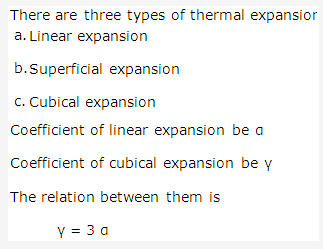
Solution 15:
Not all substances expand on heating. Some examples of substances which do not expand on heating are plastics, polythene and rubber.
Solution 16:
Evaporation is the phenomenon of a change of a liquid into vapour without raising the temperature. Evaporation needs energy for phase change from liquid to gases. As water evaporates off your skin, it absorbs energy(heat) from the body to make the phase change to gas thus cooling the body.
Solution 17:
Factors affecting evaporation are
- Humidity- more the humidity less is the evaporation
- surface area- more the surface area more is the evaporation
- wind- more the wind more is the evaporation
- temperature- more the temperature more is the evaporation
Solution 18:
The cold air that blows from land towards sea during night, is called land breeze
The cold air that blows from the sea towards the land during the day is known as the sea breeze. These breezes are the examples of natural convection current.
Solution 19:
No, the conduction is not possible in gases. Gases are bad conductors.
Solution 20:
No, conduction is not possible in vacuum.
Solution 21:
The velocity of thermal radiations is equal to the speed of light i.e. 3 x 108 m/s.
PAGE NO : 230
Solution 22:
We wear woolen clothes in winter because woolen clothes have tiny pores and air is trapped in these pores and being a bad conductor, the trapped air obstructs the flow of body heat to the surroundings.
Solution 23:
A newly made quilt is warmer than an old one because the cotton in the old quilt gets compressed and very little air will remain trapped in it, hence heat insulation is quite poor.
Solution 24:
In cold countries, water pipes are covered with poor conductors because poor conductor prevents water from freezing and thus prevent these pipes from bursting.
Solution 25:
Three devices used to detect heat radiations are
- Blackened bulb thermometer
- Differential air thermo scope
- Thermopile
Solution 26:
The increase in size of a body on heating is called thermal expansion.
Solution 27:
Linear expansion is the increase in length of a solid on heating.
Solution 28:
Coefficient of Linear expansion is equal to the change in length of a rod of length 1m when its temperature rises by 1°C.
Solution 29:
A bimetallic strip consists of two metal strips- one with high coefficient of expansion and the other with low coefficient of expansion.
Solution 30:
SI unit of coefficient of linear expansion is °C-1.
Solution 31:
Water is the substance which contracts, when heated from 0°C to 4°C.
Solution 32:
Coefficient of volume expansion is equal to the change in volume of a rod of volume 1m3 when its temperature rises by 1°C.
Solution 33:
SI unit of coefficient of volume expansion is °C-1.
Solution 34:
Two uses of bimetallic strip are
- As thermostat in electric iron
- As balance wheel in watches
Solution 35:
We should heat the neck of the bottle because due to heating the neck will expand and loosen the stopper stuck in the neck. In this way, we can easily remove the stopper from the bottle.
Solution 36:
When hot water is poured into a thick glass tumbler, it generally cracks because on pouring hot water in the tumbler the inner surface heats up and expands more as compared to its outer surface. This unequal expansion between the two surfaces causes a strain and the tumbler cracks.
Solution 37:
A substance is made up of molecules arranged in a lattice. On heating, the molecules vibrate faster in the lattice and bump into each other harder. So the distance between the molecules increases thus expanding lattice. Thus, the substances expand on heating.
Solution 38:
There are three types of thermal expansion
- Linear expansion
- Superficial expansion
- Cubical expansion
Solution 39:
Gaps are left in the railway tracks because the tracks gets heated during the day and as a result they increase in length. If the gaps are not provided, the railway line would buckle outward and may cause derailment.
Solution 40:
The beams of the bridges expand maximum during the summer days and contract maximum during the winter nights. If the beams are fixed at both ends on the pillars, they may develop crack due to expansion and contraction. To avoid this, beams are made to rest on rollers on the pillars to provide space for expansion.
Solution 41:

Solution 42:

Solution 43:

Solution 44:
A ventilator is provided in a room because it helps in removing the hot air from the room and allows the fresh and cold air to come in.
Solution 45:
No, it is not possible to heat a liquid or gas from above because the transfer of heat through convection takes place vertically upwards in liquids and gases. So if they are heated from above, the liquid or gas at the top will only be heated because most liquids and gases are themselves bad conductor of heat so they cannot conduct heat from top layer to the bottom layer.
Solution 46:
- Water is heated generally from below because water itself is a bad conductor of heat and the transfer of heat through convection take place vertically upwards.
- Land becomes warmer than water during the day because water has more specific heat capacity so it absorbs the heat and heats up slowly but on the other hand land has less specific heat and it heats up faster than water.
Solution 47:
Main characteristics of thermometric substance are
- The substance should have high coefficient of expansion so that it is sensitive to the smallest change in temperature
- The substance should have uniform expansion all over its entire volume
- The substance should have minimum specific heat so that it absorbs minimum heat from the body under measurement.
Solution 48:
Wood is an insulator of heat.
Solution 49:
- In cold countries, windows are provided with two glass panes because in between these two glass panes, a thin layer of air is present: air being a bad conductor obstructs the conduction of heat from the room to outside.
- 1 calorie = 4.2 joules
- Yes, it is possible to boil water in a thin paper cup because when heated the heat in the paper cup is transferred to the water through convection and paper cup doesn’t get sufficient heat to get burnt
Solution 50:
Thermometer works on the principle that substances expand on heating and contract on cooling. So we use a thermometric substance which expands and contracts uniformly.
Solution 51:
Advantages of mercury and alcohol as thermometric liquid are
- They both are good conductors of heat.
- They have high coefficient of expansion thus are sensitive to the smallest change in temperature
- Their freezing points are very low and boiling point is high in case of mercury
Disadvantages
- Alcohol is transparent and this makes hard to read the thermometer.
- It does not have uniform expansion.
- Mercury is less sensitive than alcohol as its coefficient of expansion is less than alcohol.
- Alcohol is a volatile liquid.
Solution 52:
Lower point of a thermometer is the temperature at which ice starts melting at normal atmospheric pressure i.e. 0°C
Upper point of a thermometer is the temperature at which water just starts boiling at normal atmospheric pressure i.e. 100°C.
Solution 53:
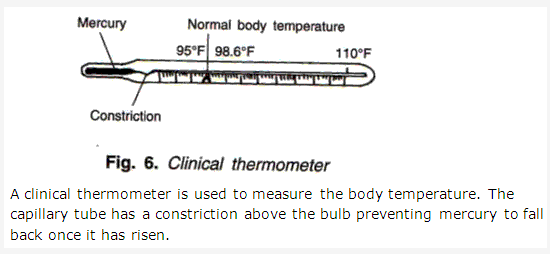
Solution 54:
- Laboratory thermometer is used to measure and observe the temperature of various chemical reactions
- Clinical thermometer is used to measure human body temperature
- Six’s maximum and minimum thermometer is used in meteorology and horticulture.
Solution 55:

Solution 56:
The temperature that is common in both clinical and Fahrenheit scale is -40°C
Derivation is as follows
Let the temperature be x
C/100= (F – 32)/180
x/100 = (x-32)/180
x * 180/100 = x-32
9/5 x = x – 32
-4/5 x =32
x = – 40
Solution 57:
- 60°C
60/100 = (F-32) / 180
F = 6 x 18 +32
= 110°F - 100°C
100/100 = (F – 32) /180
F = 180 x 1 + 32
= 212°F - -40°C
-40/100 = (F – 32) /180
F = -4 x 18 + 32
= 40°F - 85°C
85/100 = (F – 32) /180
F = 85 x 18/10 +32
= 185°F
Solution 58:
- 104°F
C = (F – 32) x 100/180
C = 72 x 100/180
= 40°C - 95°F
C = (F – 32) x 100/180
= 63 x 10/18
= 35°C - 113°F
C = (F – 32) x 100/180
= 81 x 10/18
= 45°C - 32°F
C = (F – 32) x 100/180
= 0 x 10/18
= 0°C
Solution 59:

Solution 60:
Three modes of heat transfer are
- Conduction involves the transfer of heat from the hot end to the cold end from particle to particle of the medium.
- Convection is the transfer of heat from one body to another by actual movement of the particles of the medium
- Radiation is the transfer of heat from one body to another without the need of an intervening material medium
Solution 61:
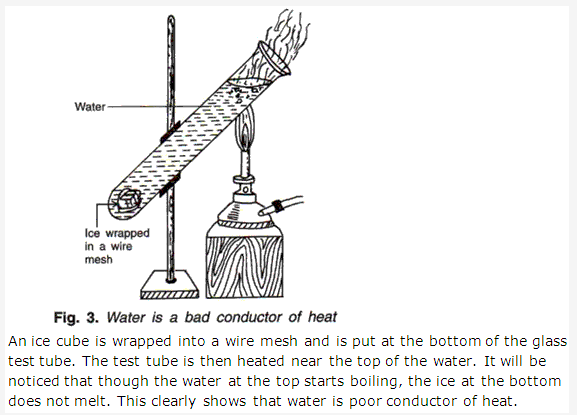
Solution 62:

Solution 63:
A wooden knob and a metal latch are both being at same temperature but it feels colder to touch the latch because metal is a good conductor and as soon as we touch it heat from our hand flows to the latch and we feel cold while on the other hand wood is a bad conductor of heat, heat of our hand does not flow into it therefore it does not feel cold.
Solution 64:
The flask consists of double walled glass container with vacuum between the walls A and B to prevent heat loss due to conduction and convection as vacuum is the excellent insulator .to prevent heat loss by radiation, the inner side of the wall A and outer side of wall B is silvered. It has a narrow mouth which is closed by a non-conducting rubber stopper.
Solution 65:
The spiral starts moving because due to the flame of the candle the spiral heats up and expands. While expanding, the spiral tries to create space for the extension in length and an outward pull is created which causes the spiral to move.
Solution 66:
- In winters, the human body covered with a blanket keeps warm because the blanket has air trapped in it which provide heat insulation to the body from the surroundings and keep us warm
- It is better to use two thin blankets to keep the body warm rather than using a single blanket of equal thickness because in between the two thin blankets there is more air trapped than in the single blanket of equal thickness so using two thin blankets better heat insulation is provided to the body from the surroundings and keep us warm
- In winter the birds fluff their feathers in order to trap air in their feathers so that the air provides heat insulation to their body from the surroundings and keep them warm and save them from winter.
- Old quilts are less warmer than new ones because the cotton in the old quilt gets compressed and very little air will remain trapped in it, hence heat insulation is quite poor
- People wear light colured clothes in winter because these clothes reflect most of the sun’s radiations and absorb only a little of them. Therefore, they keep themselves cool.
PAGE NO : 231
Solution 67:
Transformation of Sun’s energy in sun-eco system through a food chain is called energy flow.
Solution 68:

Solution 69:
Any energy transfer is not 100% because energy is lost to the surroundings in the form of heat, friction losses during the transfer of energy. Therefore complete energy is not transferred.
Solution 70:
Bio gas is produced by the action of bacteria on decaying organic matter. The primary source of bio gas in villages is dung of cow, or buffalo. The bio gas is mostly methane which can be used as a chief source of light and heat energy.
Solution 71:
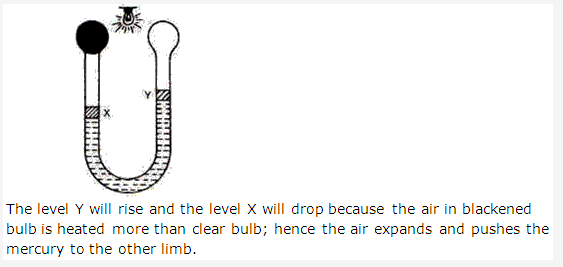
Solution 72:
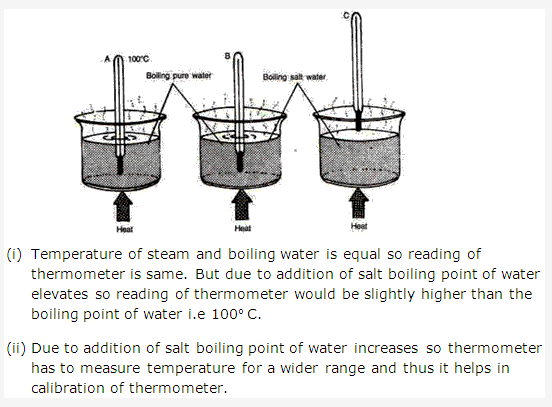
Solution 73:
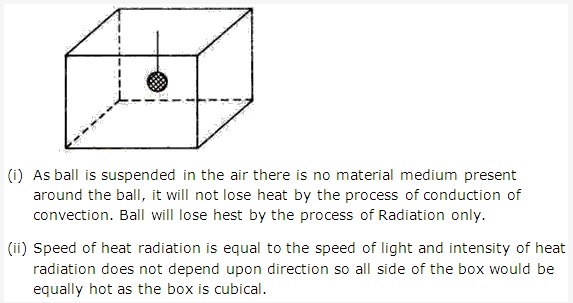
Solution 74:

PAGE NO : 232
Solution 75:

Solution 76:
Water is not used as a thermometric liquid because It has low coefficient of expansion so it is less sensitive to temperature changes. Moreover, It is transparent thus making it difficult to read the thermometer and water evaporates with time thus producing error and also the freezing and boiling points are also low.
Solution 77:
The sensitivity of a thermometer can be increased by using a substance having high coefficient of expansion and uniform expansion so that its expands with the slightest change in temperature.
Solution 78:
- When hot water is poured into a thick glass tumbler, it generally cracks because on pouring hot water in the tumbler the inner surface heats up and expands more as compared to its outer surface. This unequal expansion between the two surfaces causes a strain and the tumbler cracks.
- Pyrex glass tumbler does not crack on adding hot water because Pyrex glass has low coefficient of expansion. It does not expand less when hot water is added to the tumbler.
Solution 79:
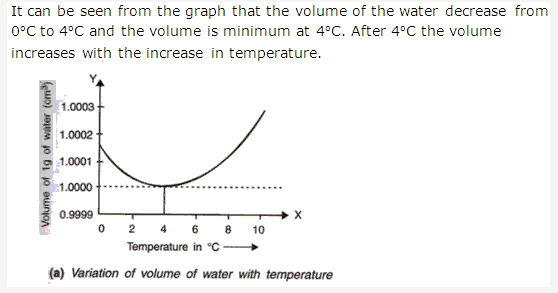
Solution 80:

Solution 81:

Solution 82:
Temperature in °C = 1°C
C/100 = (F-32)/180
F = 1 x 18/10 + 32
= 33.8°F
Solution 83:
Lower fixed point = 10°C
Upper fixed point =130°C
Range of thermometer= 130°C – 10°C = 120°C
No of divisions = 100
So least count = 120/100 = 1.2°C
On actual thermometer 40°C would have 40 divisions
So, on this thermometer it would show = 40 x LC = 48°C
Solution 84:
The green house is referred to a glass house. The heat enters the house but cannot escape out, because the glass reflects the heat back to the inside of the house. This makes glass house warmer than the outside environment. This phenomenon is called green house effect.
Solution 85:
Global warming occurs due to the presence of carbon di oxide, CFCs, methane in the atmosphere. Carbon dioxide acts as a transparent gas to incoming shortwave radiations which the earth re-radiates into space. It, therefore traps the outgoing radiations thus warming lower atmosphere of the earth thereby causing global warming.
Solution 86:
Harmful effects of global warming are
- The atmospheric temperature of earth would increase thereby making it difficult for a living being to survive
- It would melt down the polar caps thus increasing the size of the ocean and leading to floods, tsunami, etc.
- The increase in temperature would affect climate and rainfall thus affecting flora and fauna.
- Human beings would be vulnerable to diseases as microbes would get warmth to grow.
Solution 87:
The temperature in a green house rises because heat enters the house through the glass but cannot escape out, because the glass reflects the heat back to the inside of the house. This makes glass house warmer than the outside environment.
